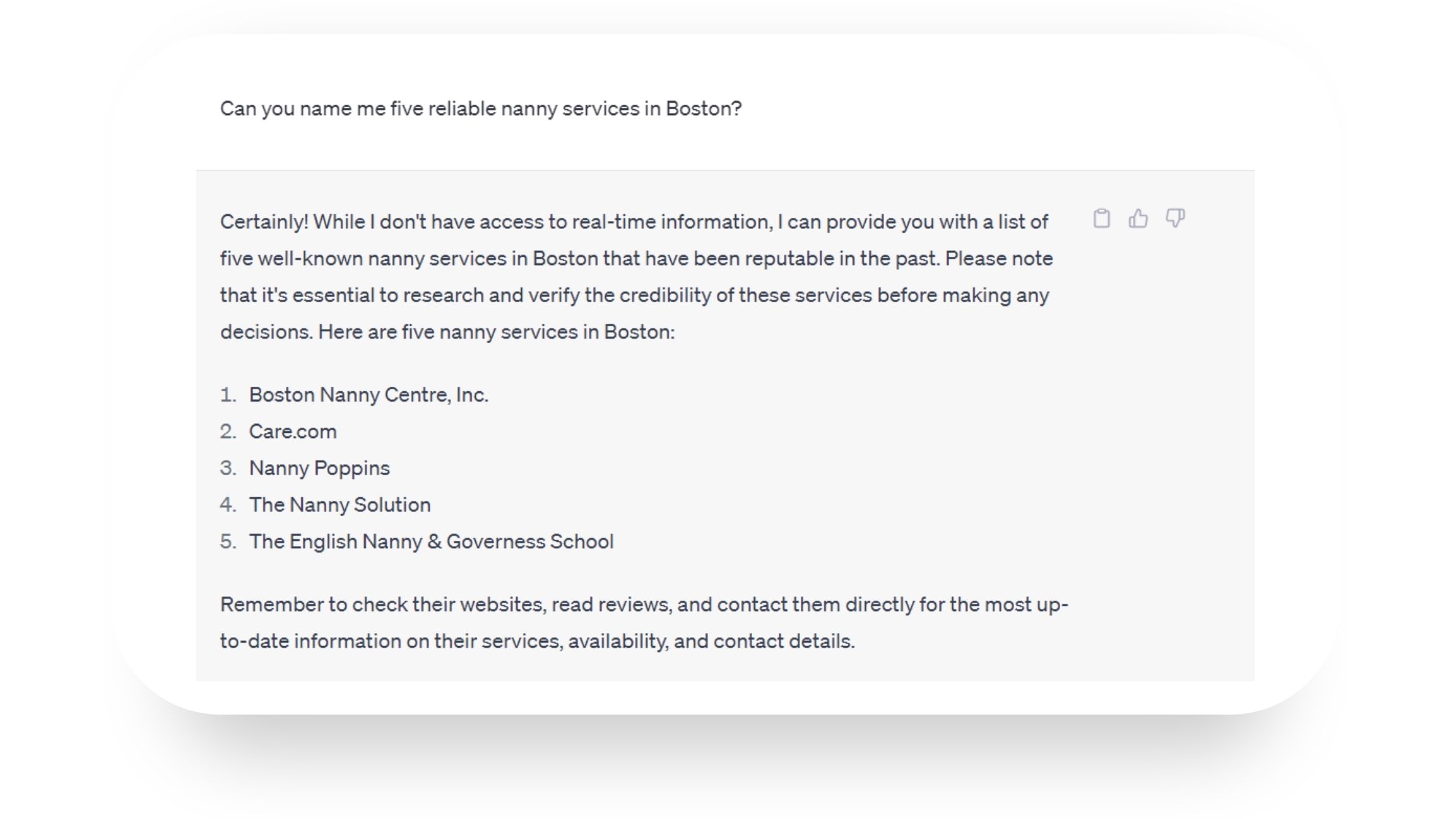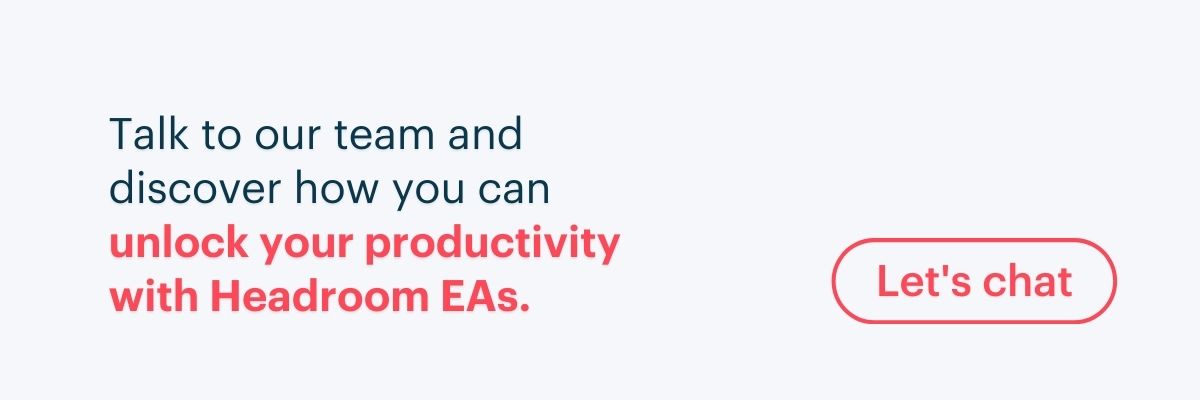Best 10 ChatGPT prompts for remote executive assistants

In many ways, executive assistants are the fuel that powers a company. On a macro level, they ensure back-office operations are on track, serve as gatekeepers, and act as researchers and copywriters.
On the micro level, executive and virtual assistants must seamlessly juggle what sometimes feels like an infinite number of tasks — and that’s where AI technology can swoop in to save the day.
Headroom executive assistants have been testing and experimenting with it and some pretty interesting case studies emerged. Keep reading to see how people in support positions can leverage artificial intelligence to save time, boost productivity, and help mold a company’s public image.
The Executive Assistant’s Role Is in Flux
In the days of old, executive assistants answered phones, transcribed notes, and scheduled appointments – all the basic secretary stuff. But things have intensified in these digital days, and the role of C-suite administrators is expanding. This means they must expertly manage countless secretarial tasks while navigating new technologies. In other words, today’s executive assistants must become efficiency superheroes and anticipate their executives’ needs.
Moreover, support staff may not even work in the same office as their bosses anymore, and there’s been a significant rise in the number of remote executive assistants. That adds yet another layer of logistical complexity.
Thankfully, among all the AI tools that are popping up across the Internet, some can genuinely help streamline processes and make the EA job a bit more manageable.
How AI Can Help Executive, Virtual, and Remote Executive Assistants
In recent months, artificial intelligence has exploded onto the scene – who else is getting their social media feeds flooded by “ChatGPT is great, BUT only if you use these prompts” kind-of-content? Once the imaginative purview of sci-fi, AI is now a part of daily business life, who would have thought!
So let’s explore a few ways to incorporate this advanced technology to enhance the productivity of an executive assistant.
Calendar Management
Today’s global marketplace demands spot-on time management skills, starting from assistants who must seamlessly schedule executives’ hours down to the minute, 24-7.
That’s where AI-powered scheduling tools come in: they can help C-suite “lieutenants” manage their executives’ calendars more effectively in less time. We tried a popular program called Clara, which can analyze meeting requests, suggest times based on availability, and send out invitations automatically.
What once took a half hour or more could now be executed in minutes. For example:
- If the executive in question doesn’t want to take meetings after a certain hour, you can prompt the system never to schedule meetings after 5 p.m.
- Increasing numbers of people are more conscious about their diet. If a given executive doesn’t want to consume caffeine after the clock strikes noon, you can set up a rule to never schedule coffee meetings after 12 p.m (They could still opt for a decaf drink though).
- Some meetings are best handled over a couple of drinks. As such, you can feed the system codewords that trigger cocktail meet-ups after 5 p.m. Cheers to new boozy partnerships!
Email Management and Copywriting
Inbox is the single most time-consuming thing for executives, but luckily AI-powered email tools can help executive assistants filter and prioritize emails faster than you can say “Inbox Zero”. For instance, programs like SaneBox and Boomerang can flag high-priority emails, sort emails by topic or sender, and even set up “stock” responses.
Let’s look at a few examples:
- Flagging a “problem” person’s emails can be helpful on several levels, allowing an assistant to intervene before a situation blows up unnecessarily.
- Identifying important emails is also important, as it catapults essential correspondences to the front of the line.
- Pre-programming automated requests and responses to regular meetings just saves a ton of time. Like an automated “no” to weekly coffee date invites from your CCO – just joking!
Travel Planning
Travel tools powered by AI can help executive and virtual assistants book flights, hotels, and rental cars in a fraction of the time. For example, platforms like Kayak announced in March 2023 that they would partner with OpenAI to integrate the best rates and flight information in ChatGPT. You can finally cut down the time it takes to execute endless searches and compare flight prices across websites!
Here are a few prompts an executive assistant can pump into an AI-enabled travel scheduler:
- Where can I fly to from NYC for under $500 in April?
- Book a roundtrip flight from New York, New York, to Los Angeles, California, on July 9.
- Suggest three restaurants near [insert hotel name] that serve vegan dishes.
- What is the most convenient car rental service near [insert location]?
Research
ChatGPT is the golden child of text generators. Arguably, it’s done for words what the calculator did for arithmetic back in the days. And when it comes to doing research quickly, ChatGPT and similar services have already become invaluable resources for executive assistants. You can ask text generators questions and receive answers in seconds, saving hours of research.
Below are a handful of ChatGPT prompts for executive assistants trying to figure out common or semi-impossible requests from their executives:
- If the executive must take their child on a business trip, you can ask ChatGPT something like “name five reliable nanny services in [insert location]?“
- Does your boss stick to a strict diet? No problem. Simply pump the parameters into ChatGPT, i.e., “Name the top 3 women-owned restaurants in [insert location] that offer keto menu options.“
- Many executives like to connect with potential new contacts when traveling. Assistants can facilitate this effort by asking text research programs to generate listicles like “top 30 biotech startups in the NL and their CEOs’ names and LinkedIn accounts.”

ChatGPT for Executive Assistants: Headroom’s 10 Best Prompts
As mentioned, ChatGPT is a powerful text generator that allows executive assistants to get complex, tailored answers to questions in a few clicks.
Let’s review some prompts our Headroom assistants have leveraged to ensure their executives cater to clients, make the best impression when courting new business, politely decline invitations, and maximize employee productivity.
Below are 10 examples of useful ChatGPT prompts for executive assistants, tested by our expert EA team.
- Recommend seven reliable nanny services in [insert area].
- Suggest 10 team-building activities for remote-first companies.
- What are nine tips for successful delegation and team empowerment?
- Write a short note politely declining an invitation to attend a panel talk about sustainable fashion due to conflicting priorities.
- What are five lesser-known tips and tricks to optimize Gmail as an executive assistant?
- Create a professional and engaging voicemail script for [insert industry].
- Write an encouraging and calming response to a stakeholder [define] who wants help with [insert topic].
- My priority for this week is [insert goal]. Break it down into smaller tasks and provide a timeline for getting it all done.
- Summarize this article in 50 words or less: [paste article].
- Identify the top five trends in the [industry] industry and write a 500-word article about them.
The Limits of ChatGPT
AI programs have taken the business world by storm, which has many people asking: Will AI put all executive assistants out of business?
Not quite.
Notably, many companies saw dollar signs when ChatGPT first hit the market and hastily fired copywriters and freelancers. But as people become more familiar with the program, they’re discovering its limitations.
So while platforms like ChatGPT, Google’s Bard and Bing AI are incredible tools that are dramatically changing the market landscape, they aren’t a bullet-proof solution. To that end, let’s review the top limitations of AI text generators.
- Limited Data: Text generators are like databases in that they’re only as good as the information they’re fed. Programs like ChatGPT and Bing AI only have data up to 2021, so they may give outdated responses.
- Inaccuracy: AI programs gather information from the Internet to generate responses. However, not everything you read online is accurate. As such, double-checking feedback is vital.
- Input Sensitivity: The way you input a prompt significantly impacts the response. So a simple typo or poor word choice can lead to problematic output.
- Bias: Several studies show that text generators can be as biased as humans. Therefore, you still need someone to review all generated text for explicit and implicit prejudice.
- Plagiarism: The last thing you want is to plagiarize a competitor. As such, running all AI-generated copy through a content checker is good practice.
- Data Privacy: Since AI chat tools are digitized, the risk of hacking looms large. And there are already been cases of employees feeding ChatGPT sensitive company information that was leaked (Samsung experienced that first-hand).
Final Thoughts
AI is here to stay, there’s no questions about it. And when properly leveraged, it can be a powerful tool for executive assistants, allowing for better strategic support and improved productivity. Using programs like Clara, SaneBox, Boomerang and ChatGPT can help EAs step up their time management skills, plan trips in a jiffy and do extensive research faster.
We hope this article helped explain how to use ChatGPT as an assistant and let go of the fear of being replaced. Ultimately, the key is playing around and testing prompt word choices. Eventually, you’ll find a rhythm and make the most of the exciting new tools hitting the market.
